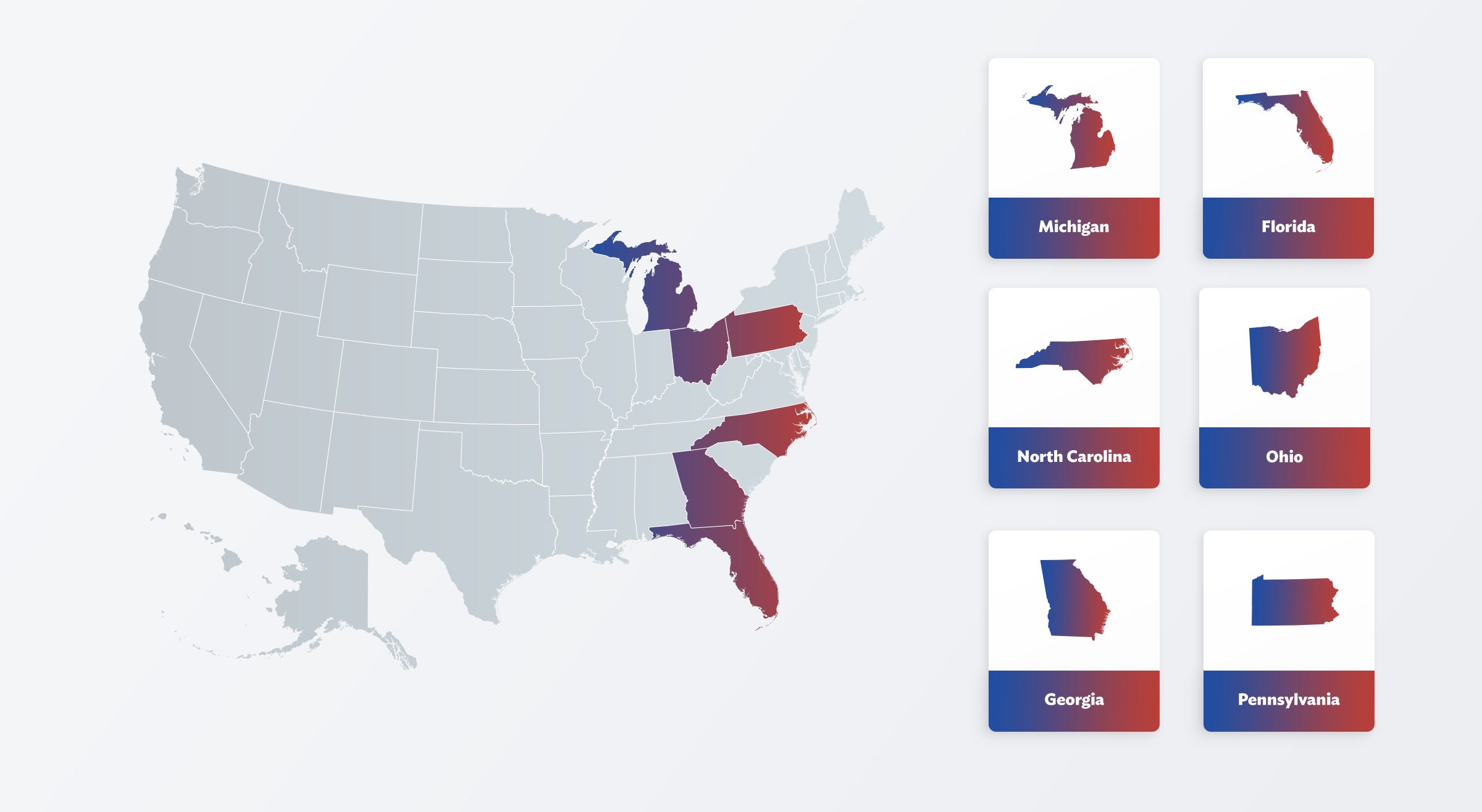Predicting 2020: Trump wins again
Our latest polls show Trump wins again. The pollsters were wrong again. And this time we know why.
By David Burrell | CEO & Co-Founder of Wick
Wick is not a partisan polling company. We exist to create technology and thought leadership that accelerates the market research industry’s journey to more speed, affordability, and accuracy. We withheld this article until the day before the election to limit the politicization of its data and insights for the media interests of either party.
From the author:
We are predicting that Donald Trump is going to win re-election. In our most recent battleground polls in the 6 states of Florida, Pennsylvania, Michigan, Georgia, North Carolina, and Ohio he is up by over 2% in all but Michigan (for those results scroll to the end of this article).
But what’s more interesting than our prediction that he will win, and why we are writing this article, is that all of our polls until last week had Trump losing by similar margins to what you have probably seen in the news.
What caused this change? It had little to do with either team’s campaigning because we can still easily conduct a poll that has Biden up by a large margin. Instead, it was our methodology that changed. We still used similar tactics that helped us accurately predict every battleground state in 2016: Nearly the same questionnaire design, random samples of likely and newly registered voters, no live agents, etc… But otherwise, we pretty much threw out the book of traditional assumptions made about data sampling. We decided to question everything as we started our field program.
Why did we throw out the book the week before an election when we had relied on its methods for hundreds of polls? It definitely wasn’t because excited to tell dozens of political consulting and public affairs clients on both sides of the aisle that the work we have all been doing might have a methodology problem. But end-of-the-day, our team has been involved in elections for 12 years, done thousands of polls, built a company that created an opinion research technology that is used by dozens of companies- and something just didn’t look or feel right (which was a good enough reason as any to check our premises). This feeling had been around for a whilebut the final decision came a week or so ago I was trying to listen to a Biden speech on the tv and couldn’t hear him over the sound of Trump supporters honking their horns. I joked that we needed to tally the honks because I have run hundreds of polls this year and this is the first I have heard from this group of voters… That they were the new “hard to reach segment” and this was precious data.
It was just a joke but it really made me start to wonder how much truth there was to it and so we decided to find out. What follows (in addition to the results of the polls shown further down) is our best shot at explaining what we saw when we checked our premises and why everyone got it wrong… again.


Before we get into the results and insights…
Before we get into insights from the new battleground polls, it might be helpful to understand the lens through which we were analyzing the data with something that most public opinion researchers can agree on:
Accurate public opinion polling is only possible in democracies where people trust the democratic process and feel the freedom to express their beliefs and opinions. If it ever seems like sorcery that 700 respondents in a survey could ever accurately predict the election day behavior of millions, then the source of that magic is a healthy democracy.
Imagine the difficulty in achieving an accurate political poll — one that’s supposed to be representative of the honest beliefs of an entire population of people — in Communist China or North Korea. Would you trust it?
To point at China and North Korea may seem extreme, but it’s the easiest modern-day example to help illustrate the fact that there are certain characteristics of undemocratic societies such as limited freedom of expression and propaganda that make it difficult or impossible to obtain a set of survey respondents that is representative of a whole population.
In western democracies like America, having your beliefs and opinions represented through polling has been a long-standing part of participating in the democratic process. And thus, like the debate commission and the media, pollsters have been fixtures in the democratic process. But in 2020 especially we have started to demonstrate some pretty undemocratic characteristics that could be putting stress on the magic behind that ability for public opinion research to be truly representative. To put it into plain words:
1 | If one belief group is championed for its beliefs and another is continually attacked and threatened, which group do you think is more likely to share its beliefs in a poll?
2 | If the media intentionally censors information and promotes misinformation, how does that affect people’s image of the worth of the polls they see in the news? Could that affect their likelihood to associate polls with a democratic process that they can trust? If so, then what is the incentive to take polls in the first place?…
Again, up until a week ago, the idea of this underrepresentation was just theory. But once our team hypothesized the problem, designed a polling study to test it, tease out these symptoms, treat them, and then see what happens. We chose 6 battleground states and collected 1,000 completes in each state from a random sample of likely and newly registered voters from 10/24 –10/25. IVR and Text-to-Web survey methods were used to collect the responses.
Wick’s 2020 final battleground poll, insights, and results.


What were the key findings?
We approached this polling project with a “question everything” mindset and we were looking for any inconsistencies that might suggest that a portion of society might not be voicing their opinion in 2020 at the same rates they did in our 2016, 2012, and 2008 polls. If we found any of these symptoms then we would do what we could to adjust our sampling techniques and adjust our methodology to treat. We found many symptoms that can mostly fit into the 3 categories below.
Symptom 1: Strange Response Rates
In 2016 education was an issue that made polls wrong and most pollsters are trying to adjust (I will add here that if any pollster isn’t controlling for education and/or has grouped graduate and post-graduate degrees together as “college grad or higher” then they will still have a 2016-esque problem with their accuracy). In 2020 education is a symptom rather than the problem itself. Voters with post-graduate degrees historically answer polls at higher response rates than less-educated voters. But that doesn’t explain 23% – 31% of day 1 survey respondents answering that they had a post-graduate degree. Why are “some college” and “no college” segments of the population answering at rates much lower than in 2016?
Symptom 2: Unexplained Negative Space
The raw responses from the battleground polls data show a nearly 3x increase in African American and 2x increase in Hispanic support for Trump when compared to 2016. It should follow that there is a counterpart of white voters with the same socio-economic status as these African Americans and Hispanics who Trump is doing well with, but they are not showing up in the polling? Pollsters might argue that this group is taking the polls, but they aren’t voting for Trump, and that they are shown in Biden’s gains with these Anglos. Could be true, but that argument is hard to hear through all the honks so we still considered it to be a symptom.
Symptom 3: Polling vs Real Life
Admittedly, there is not a historical model with which to compare the 2020 voter turnout. Still, early voters (and absentee ballot voters in particular) were extremely overrepresented after our first day of fielding with the percent of people who answered that they “already voted” being on average 16% higher than the actual percentage of people that had voted by that day. Across the 6 battleground states, only 36.5% of this group said they voted for Trump meaning that his support was being significantly underreported.
What happened when we treated for these symptoms in our last battleground poll?
So now we are at the punchline and here is what we think:
- Trump is going to win a historic percentage of African Americans and Hispanics vote (which will probably be the go-to-explanation for why polls were wrong).
- Pollsters acknowledge this shift in minorities and believe that this ground is covered by Biden’s gains in white voters in all demographics, but this ground is not covered because those gains are with white voters who are willing to take polls (which should be the go-to-explanation for why polls were wrong).
- If Biden does win in a close race, after polls showed a blowout for months, we need to ask why public opinion polling isn’t working in our democracy.


Written by

